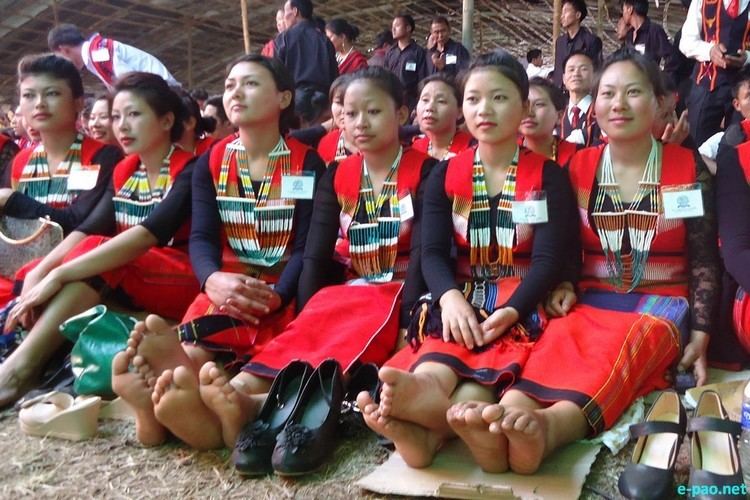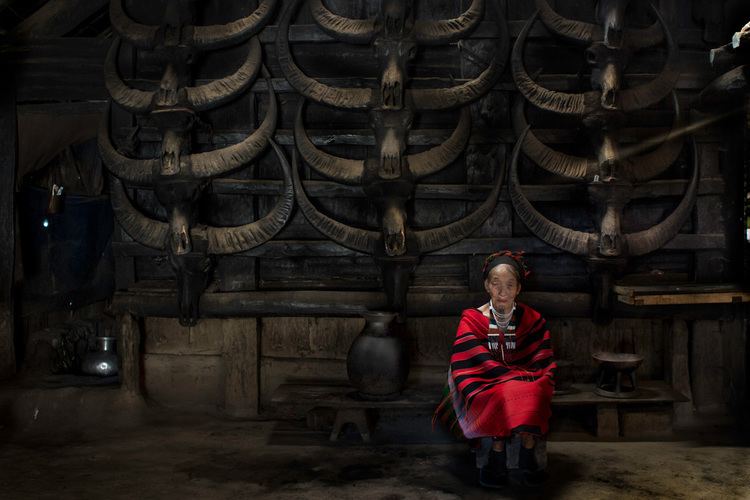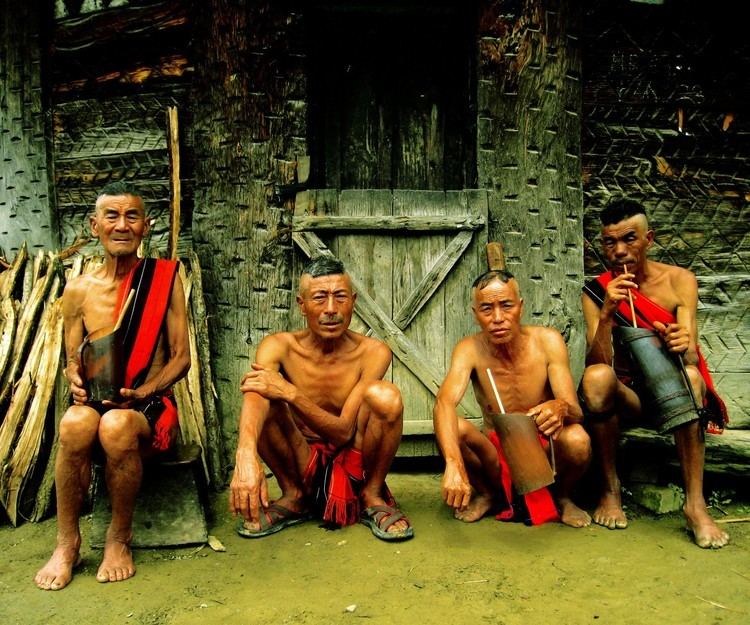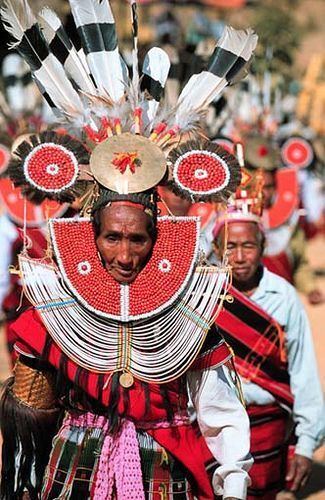 | ||
Tangkhul naga community showcases their rich culture traditions in mumbai
Tangkhul is a tribe living in the Indo-Burma border area occupying the Ukhrul district in Manipur, India and the Somra Tangkhul hills (Somra tract) in Upper Burma. Despite this international border, many Tangkhul have continued to regard themselves as "one nation".
Contents
- Tangkhul naga community showcases their rich culture traditions in mumbai
- Tangkhul naga tribe dance in nagaland north east india
- History
- Language
- Literacy rate in first language
- Literacy rate in other languages
- Culture
- Music and dance
- History of Christianity in the Tangkhul culture
- References

Tangkhul naga tribe dance in nagaland north east india
History

The Tangkhuls, as with other tribes on the hills, came to Manipur, Nagaland, Assam and Arunachal Pradesh from China through Myanmar entering their present habitats in successive waves of immigration. The Tangkhuls came together with the Maos, Poumeis, Marams and Thangals because all of them have references to their dispersal from Makhel, a Mao village in Senapati district. They had also erected megaliths at Makhel in memory of their having dispersed from there to various directions.

The Tangkhuls point to the association of their forefathers with the seashore. Most of the ornaments of the Tangkhuls such as kongsang, huishon, etc. were made of sea shells, cowrie and conch shells a prominent feature of the people who live on the shore.

By the 2nd century A.D. the Tangkhuls were living in Samshok (Thuangdut) in Myanmar. Ptolemy, a Greek astronomer and geographer of Alexandria, in his Geography of Further India, c. 140 A.D., referred to the Tangkhul at Triglypton (Thuangdut). The Tangkhuls began disperse from Samshok after the invasion of Ko-lo-feng and his successor I-mau-shun the king of Nan-chao in the closing part of the 8th century A.D. and beginning of the 9th century A.D. They were further driven towards the north west of Myanmar by the Shan people.

Thus, the Tangkhuls as also other tribes who travelled from China to Myanmar and from there finally they came into their present land traversing through innumerable snow-covered landscapes, mountains and wild forests confronting wild beasts and wild tribes may be grouped collectively as Naga on the basis of ethnicity. The exodus of the Tangkhuls from China to Myanmar and finally to India is indeed a story of heroism of human courage and endurance in the face of great famine in China during those days.

In course of time every Tangkhul village became a small republic like the Greek city states. Every village had an unwritten constitution made up of age-old conventions and traditions. The Tangkhul villages were self-sufficient except for salt, and self-governing units ruled by hereditary or elected chief assisted by a Council of Elders. The chief was a judge, administrator and commander rolled into one.
Hunphun was the headquarters of the Tangkhul Long (Tangkhul Assembly), as well as the Tangkhul annual fair locally known as “Leih Khangapha” used to be held at Somsai in Ukhrul.
The boundary of Manipur and Burma (Myanmar) was laid down by an agreement signed between the British authorities (East India Company) and Burma on 9 January 1834 on the river bank of Nighthee (Chindwin). The Article No.4 (iii) of this agreement relates to the Tangkhul country. “Fourth (iii) - On the north, the line of boundary will begin at the foot of the same hills at the northern extremity of the Kabo Valley and pass due north up to the first range of hills, east of that upon which stand the villages of Chortor (Choithar), Noongbee (Nungbi), Nonghar (Lunghar), of the tribe called by the Munepooriis (Manipuris) Loohooppa (Tangkhul), and by the Burmahs Lagwensoung, now tributary of Manipoor.” As a result of this boundary demarcation without the knowledge let alone consent of the Tangkhuls, many Tangkhul villages situated in the Somrah hills are included under Burma. Later, when India and Burma attained national independence, the Tangkhuls found themselves belonging to two different countries.
Language
The Tangkhul tribe has more than a hundred dialects - each village has its own dialect including Khangoi, Khunggoi, Kupome, Phadang, Roudei and Ukhrul. Tangkhul is the principal dialect. Although the Tangkhul Naga tribe speaks more than a hundred dialects, the lingua franca is the Hunphun (Ukhrul) dialect.
A slightly modified English alphabet is used. Tangkhul Language is included in the CBSE syllabus and is the first Tribal language from North East India to be included in the CBSE syllabus.
Literacy rate in first language
Because of the diversity in dialects and lack of a standardized language, it is difficult to gauge the literacy level. However, if the knowledge of Tangkhul is taken as an indicator, most young Tangkhuls are losing their grasp of the language, often preferring to use the English language to describe more complex ideas. There are some important factors that contribute to the standardization of English language as the primary medium of learning and communication. Firstly, there are various concrete and abstracts objects and ideas which cannot be termed in Tangkhul language, simply because unlike the English language it does not have a rich vocabulary. Secondly, the emergence of western education, which rapidly change and uplift the live and standard of Tangkhuls led the people to neglect learning the language and hence became a secondary subject. Thirdly, the idea of globalization captures the attention of the people to neglect their own language and culture.
Literacy rate in other languages
English is taught in primary schools, and the number of people able to read the Roman script is high. Almost all young people can read and write the Roman script; older people are less proficient. The literacy rate is 73%. There are English and bi-lingual publications, such as the magazine The Legacy and the English newspaper The Aja Daily. Aja is edited by Mrs Valley Rose Hungyo, the only lady editor of the state. A new bi-lingual daily newspaper The Shirui Lily Times was started in Ukhrul district headquarters from August 16, 2010. Owned and published by Shimreingam A.Shatsang, The Shirui Lily Times is jointly edited by the publisher himself and another dynamic editor Ngakuini A Shatsang. With this new edition-Ukhrul now has two local dailies published in Tangkhul.
Culture
The culture of Tangkhul revolves around traditional beliefs and custom exercises being passed down, and ancient tools and materials, like spears, swords, shields, bows, axes and spades. Culturally, the Tangkhuls share close affinities with the Meeteis of the Imphal Valley.
The Tangkhuls are fond of singing, dancing and festivities. For every season, there is a festival that lasts almost a week. Luira phanit is a major one among many festivals and some famous festivals like Yamphat (kolkanshai) of Peh is no more celebrating. The Tangkhuls' artistic creativity is manifested in their handicrafts and wood carvings.
The Tangkhul culture influences to many younger, which is totally accepted egalitarian ethos, there was no caste or classes in the society. Every person is equal in the society and the society follows patriarchal system.
The life and art of the Tangkhul are attractive and captivating. Their different clothing, utensils, architecture, monumental erections and memorial set-ups depict their dexterity in art, which also speak of their sense of beauty and finesse. Though there are common articles of unisex clothing, there are also some articles of clothing exclusively meant for men or women. Some of the traditional clothing Clothes/Shawls Man's Women's 1. Haora (man's mostly) 1. Malao 1.Phangyai 2. Chongkhom (women's mostly) 2. Laokha 2. Kahang Kashan 3. Tangkang (for man and woman) 3. Kahang Malao 3. Seichang Kashan 4. Luirim (man’s mostly) 4. Thangkang 4. Thangkang Kashan 5. Raivat Kachon (common) 5. Khuilang Kashan 6. Khuilang Kachon (woman’s mostly) 6. Kongrah Kashan 7. Phingui Kchon (common) 7. Shanphaila 8. Phaphir (common) 8. Kuiying Muka (upper cover) 9. Phorei Kachon (man’s mostly) 9. Zingtai Kashan 10. Luingamla Kashan
Music and dance
Tangkhuls are music lovers and their songs are soft and melodious. Apart from encoding into the music the varied seasonal and cultural ideas and philosophies, music is a medium wherein historical events are also related in the lyrics. In as much as religious fervor is incorporated and composed in the songs, the romantic nature of the people also finds its expressions in the music. There are various varieties of songs, some are mood special, some are festival/seasonal specials. These folk songs and folklores can be taught and sung by anybody, anytime, but there are also some specific musical expressive melodies of every region or area. People are restricted from singing certain songs outside of particular seasons or occasions. Some festivals have ceased since the introduction of Christianity to the region.
These folk songs and folklores can be played or accompanied by musical instruments. Some of the musical instruments are tingteila (violin), tala (trumpet), pung (drum), mazo (woman's mouth-piece), sipa (flute), and kaha ngashingkhon (bamboo pipe).
Corresponding to the rhythmic composition of the songs, the dances of the Tangkhuls are also rhythmic and these are eventful and vigorous. There are also some special occasional dances, like the Kathi Mahon, a dance for the dead; Laa Khanganui, a virgin dance during Luira Festival; and Rai Pheichak, a war dance. Rewben Mashangva, a member of the Tangkhul community, is instrumental in popularising the music of the community to the world. The majority of the youth know how to play the guitar and other musical instruments. However, Western culture has been blamed for the declining popularity of some ancestral songs.
History of Christianity in the Tangkhul culture
Christianity is a large part of current Tangkhul Naga culture. Tangkhul people were the first community in Manipur to become Christian. Christianity was first brought to the Tangkhul people by Rev. William Pettigrew in 1895. The story goes that the chief of Hunphun, Raihao, had stories about his great grandfather dreaming that a white missionary would come to Ukhrul. Because of this, when Rev. Pettigrew showed up, Raihao allowed him to live among them and work as a missionary. When the chief was converted, the whole tribe converted as well, and Christianity has remained a prominent religion among Tangkhul Nagas to this day.
